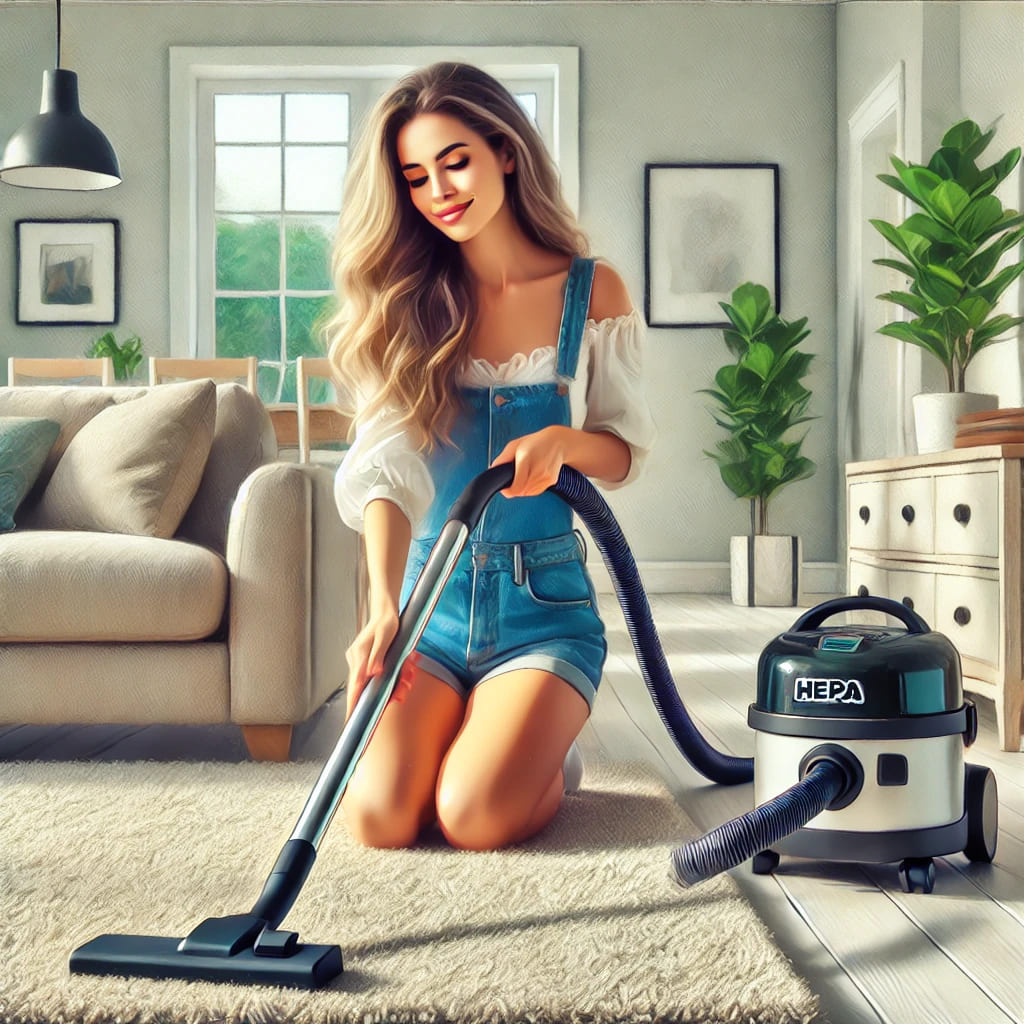Welcome to Home Well Hub!
At Home Well Hub, we understand how frustrating it can be to battle dust and allergens, especially when they sneak back no matter how often you clean. You’ve come to the right place! Here, we don’t just offer tips—we provide practical solutions that truly work. By the time you finish reading, you’ll have simple, effective habits to create a dust-free home that feels fresh, clean, and healthier for your family. Let’s make your home the comfortable, allergen-free space you deserve!
Dust-Free Home: Introduction

Meet Sara, a busy working mom who had just moved into her dream house—a cozy space filled with sunlight and warmth. But her excitement faded quickly when dust became an uninvited guest, settling on every surface no matter how often she cleaned. Even worse, her daughter’s sneezing fits grew more frequent, leaving Sara worried and frustrated. She tried every quick fix but nothing worked. One morning, as she wiped yet another dusty shelf, she had a realization—it wasn’t about cleaning harder but smarter. That day marked the start of her journey to discovering simple daily habits that transformed her house into a truly dust-free home. Ready to learn Sara’s secrets? Let’s dive in!
READ MORE: DIY SKINCARE: 5 RECIPES AND BENEFITS TO TRY IN 2025
Dust-Free Home: Morning Window Routine

Sara always believed that keeping windows tightly shut would prevent dust from entering her home. But over time, she noticed the air inside felt stuffy, and the dust kept piling up regardless. One morning, while visiting a neighbor, she noticed how fresh and clean their home felt. The secret? A simple habit—opening windows early in the morning for 10-15 minutes.
The key here is timing. Early mornings usually have lower pollen and dust levels, especially before the day’s hustle kicks in. This short burst of fresh air improves ventilation, reducing indoor dust buildup and allowing stale, dusty air to escape. Sara started doing this daily, creating cross-ventilation by opening windows on opposite sides of her home.
At first, she was skeptical. But within a week, she noticed a real difference—less dust settled on her furniture, and the indoor air felt lighter and cleaner. Plus, her daughter’s sneezing reduced significantly. This simple, often overlooked habit became the foundation of Sara’s dust-free home routine. It required no extra effort, just the right timing and consistency. Sometimes, it’s the smallest changes that bring the biggest results.
Dust-Free Home: Ditching Clutter for Clean Air

After mastering her morning window routine, Sara felt a noticeable difference in her home’s freshness. But dust still found sneaky hiding spots, especially on shelves crammed with decorative items, books, and trinkets she rarely touched. One day, while dusting for what felt like the hundredth time, she had an “aha” moment—the more stuff you have, the more dust you collect.
Determined to tackle this, Sara started a decluttering mission. She sorted through her living room, bedroom, and even her kitchen, keeping only the items that truly mattered. Out went the old magazines, unnecessary knick-knacks, and forgotten souvenirs. She chose simple, easy-to-clean décor and left plenty of open space. The result? Dust had fewer places to settle.
Surprisingly, Sara found this not only reduced dust but also made her home feel more spacious and calming. Cleaning became quicker because there were fewer things to move around. Plus, she discovered a minimalist charm she never knew she liked.
By ditching clutter, Sara took another big step toward her dust-free home. It wasn’t just about aesthetics—it was about creating an environment where clean air could flow freely, and dust had nowhere to hide.
Dust-Free Home: The Power of Microfiber Magic

After decluttering her space, Sara’s home felt lighter, but dust still managed to settle on her furniture. Frustrated with traditional dusters that just moved the dust around, she stumbled upon a game-changer—microfiber cloths. Unlike regular rags, these cloths are designed to trap dust, not just push it from one surface to another.
Sara swapped out all her old dusters for microfiber cloths and immediately noticed the difference. The tiny fibers in the cloths created a static charge, attracting and holding onto dust particles like a magnet. No more dust floating back into the air only to resettle minutes later. She started using them dry for light dusting and slightly dampened for stubborn spots, making cleaning faster and more efficient.
What’s more, microfiber cloths are reusable and eco-friendly. Sara loved that she wasn’t wasting paper towels or using harsh chemicals. This small change saved her time, reduced cleaning frustration, and contributed to her mission of maintaining a dust-free home. Now, dusting felt less like a chore and more like a quick, satisfying task that kept her home fresh and spotless.
Dust-Free Home: Shoe-Free Zones

Sara thought she had conquered dust with her new cleaning routine, but it still crept into unexpected corners—especially near entryways. One day, while visiting a friend’s spotless home, she noticed something simple yet effective: a strict no-shoes policy indoors. Her friend explained how shoes carry in dust, dirt, pollen, and even invisible allergens from outside.
Inspired, Sara decided to implement this habit in her own home. She created a cozy shoe rack near the entrance with a small bench, making it easy for family and guests to remove their footwear. To keep things comfortable, she added soft indoor slippers for everyone. It felt like a small change, but within days, she noticed significantly less dust and dirt on her floors.
This habit didn’t just reduce dust; it made her home feel cleaner, cozier, and even healthier. Sara’s daughter’s allergies improved, and cleaning the floors became quicker since she no longer had to battle outdoor grime. By establishing shoe-free zones, Sara took another smart step toward a truly dust-free home, proving that sometimes, the simplest habits can make the biggest difference.
Dust-Free Home: Vacuum Smarter, Not Harder

Sara thought vacuuming was already part of her dust-fighting routine, but despite her efforts, dust still lingered in corners and carpets. One day, while reading about indoor air quality, she discovered that not all vacuums are created equal. The secret? A vacuum with a HEPA filter—designed to trap even the tiniest dust particles, allergens, and pet dander that regular vacuums often miss.
She decided to invest in a HEPA-filter vacuum and learned a simple trick: slow, steady passes were more effective than quick back-and-forth motions. Instead of rushing through the task, Sara vacuumed methodically, especially in high-traffic areas, under furniture, and along baseboards where dust loves to hide.
The results were impressive. Her carpets looked fresher, the air felt cleaner, and the dust didn’t return as quickly. Even her daughter’s allergy symptoms improved noticeably. Sara realized that vacuuming wasn’t just about frequency—it was about using the right tool and technique. This small adjustment made a big impact, bringing her closer to maintaining a truly dust-free home, where every breath felt lighter and every corner stayed cleaner for longer.
Dust-Free Home: Bedding Makeover for Allergen Control

Despite her progress, Sara noticed that her daughter still woke up sneezing occasionally. She realized that dust wasn’t just settling on surfaces—it was hiding where she least expected: in the bedding. Mattresses, pillows, and blankets are perfect homes for dust mites, which can trigger allergies even in the cleanest homes.
Determined to tackle this, Sara gave her family’s bedding a complete makeover. She switched to hypoallergenic pillow and mattress covers, designed to block dust mites from settling inside. She also started washing bed sheets, pillowcases, and blankets in hot water every week, as high temperatures kill dust mites effectively. Fluffy decorative pillows and heavy comforters were minimized to reduce dust traps.
The difference was almost immediate. Sara’s daughter’s morning sneezes reduced, and the bedroom felt fresher and lighter. Even Sara noticed she was sleeping better, breathing easier through the night. By prioritizing her bedding routine, she realized how much hidden dust can affect daily health. This simple habit became a cornerstone of her dust-free home strategy, proving that clean, fresh air starts with where you rest your head.
Dust-Free Home: Humidity Control for a Fresher Home
Even with all her efforts, Sara noticed that dust still lingered in certain corners of her home. After some research, she discovered a hidden culprit—humidity levels. Too much moisture in the air can cause dust to clump and settle, while air that’s too dry makes dust particles float around more easily. The key was finding the right balance.
Sara invested in a simple hygrometer to monitor indoor humidity. She aimed to keep levels between 40% and 50%, which is ideal for reducing dust and allergens. During dry seasons, she used a humidifier to prevent dust from becoming airborne. In humid months, she relied on a dehumidifier and opened windows strategically to let fresh air circulate.
The impact was noticeable. The air felt fresher, and dust didn’t settle as quickly on surfaces. Sara even added a few indoor plants like peace lilies and snake plants, which naturally help regulate humidity while purifying the air. This small change not only improved her home’s air quality but also created a more comfortable, dust-free living space. With proper humidity control, Sara completed the final piece of her dust-free home puzzle, ensuring her family could breathe easy all year round.
Read More: 7 time-wasting places at home you do not need to clean regularly
Dust-Free Home: Conclusion
Sara’s journey to a dust-free home wasn’t about drastic changes or expensive solutions. It was the small, consistent habits that made the biggest difference. From opening windows early in the morning to controlling humidity levels, each simple step transformed her home into a cleaner, healthier space. More importantly, these habits eased her daughter’s allergies, giving Sara peace of mind.
What started as a struggle with stubborn dust turned into a discovery of mindful living. Sara’s story shows that maintaining a dust-free home isn’t just about spotless surfaces—it’s about creating a comfortable, breathable environment where your family can truly thrive. Now, her home isn’t just clean; it’s a haven of fresh air, warmth, and health.
Dust-Free Home: Learning Outcome
Sara’s story teaches us that achieving a dust-free home isn’t about endless cleaning but adopting smart, consistent habits. Small changes like managing humidity, decluttering, and using the right tools can significantly reduce dust and allergens. It’s not just about a spotless home—it’s about creating a healthier environment where your family can breathe easy and feel comfortable. The key lesson? Consistency matters more than perfection. With simple daily routines, anyone can transform their home into a cleaner, fresher, and healthier space without feeling overwhelmed.
Dust-Free Home: Key Takeaways
- Open windows early in the morning to improve ventilation.
- Declutter regularly to reduce dust-collecting surfaces.
- Use microfiber cloths for effective dust trapping.
- Establish a no-shoes policy indoors to limit dirt and dust.
- Vacuum slowly with a HEPA filter for thorough cleaning.
- Wash bedding weekly in hot water and use hypoallergenic covers.
- Maintain indoor humidity between 40–50% to control airborne dust.
- Small, consistent habits are more effective than deep cleaning sprees.
- A dust-free home promotes better health and reduces allergies.
- Creating a clean, fresh environment is simple with daily routines.
FAQs
How to stop dust in a house?
To stop dust in a house, focus on reducing its sources and controlling its spread. Start by establishing a no-shoes policy indoors to prevent outdoor dirt from entering. Declutter your space to eliminate dust-collecting surfaces. Use microfiber cloths for dusting, as they trap particles effectively. Regularly vacuum carpets and floors with a HEPA-filter vacuum to capture fine dust. Washing bedding weekly in hot water, controlling humidity levels, and ensuring proper ventilation will also help maintain a dust-free home.
How to create a dust-free house?
Creating a dust-free home involves consistent daily habits. Open windows in the morning to improve airflow, but avoid peak pollen hours. Declutter to reduce surfaces where dust can settle. Use microfiber cloths and vacuum with a HEPA filter regularly. Maintain optimal humidity (40–50%) to prevent dust from becoming airborne. Also, wash fabrics like curtains, bedding, and cushions frequently. Small changes, when done consistently, can significantly reduce dust buildup in your home.
How to keep a house clean every day?
To keep a house clean daily, establish simple routines. Make your bed each morning to start the day organized. Wipe down surfaces with a microfiber cloth to prevent dust buildup. Do a quick sweep or vacuum in high-traffic areas. Declutter regularly to reduce mess. Set small cleaning goals for each day, like tackling one room at a time. Consistency is key—spending just 15–20 minutes daily can maintain a tidy, dust-free home without feeling overwhelmed.
What is the simple trick to eliminate dust?
The simplest trick to eliminate dust is to use microfiber cloths for dusting. Unlike regular cloths, microfiber traps dust instead of pushing it around. Pair this with regular vacuuming using a HEPA filter, which captures fine dust particles from carpets and floors. Keeping windows slightly open in the morning for fresh airflow and maintaining humidity levels between 40–50% also helps. These small yet effective steps can make a big difference in achieving a dust-free home.
How to remove dust from air?
To remove dust from the air, start by using an air purifier with a HEPA filter, which effectively captures airborne particles. Control indoor humidity levels between 40–50% to prevent dust from floating around. Keep windows open during low-pollen hours for fresh airflow. Adding indoor plants like peace lilies can also help improve air quality naturally. Regular vacuuming and dusting with microfiber cloths reduce the amount of dust that can circulate in the air, contributing to a dust-free home.
How to reduce dust in a bedroom?
Reducing dust in a bedroom starts with your bedding. Wash sheets, pillowcases, and blankets weekly in hot water to kill dust mites. Use hypoallergenic pillow and mattress covers to prevent dust buildup. Keep clutter to a minimum, especially on nightstands and shelves. Vacuum carpets and rugs regularly with a HEPA filter. Avoid heavy curtains that trap dust—instead, opt for blinds or washable fabrics. Lastly, control humidity levels to prevent dust from becoming airborne, ensuring a cleaner, dust-free home environment.